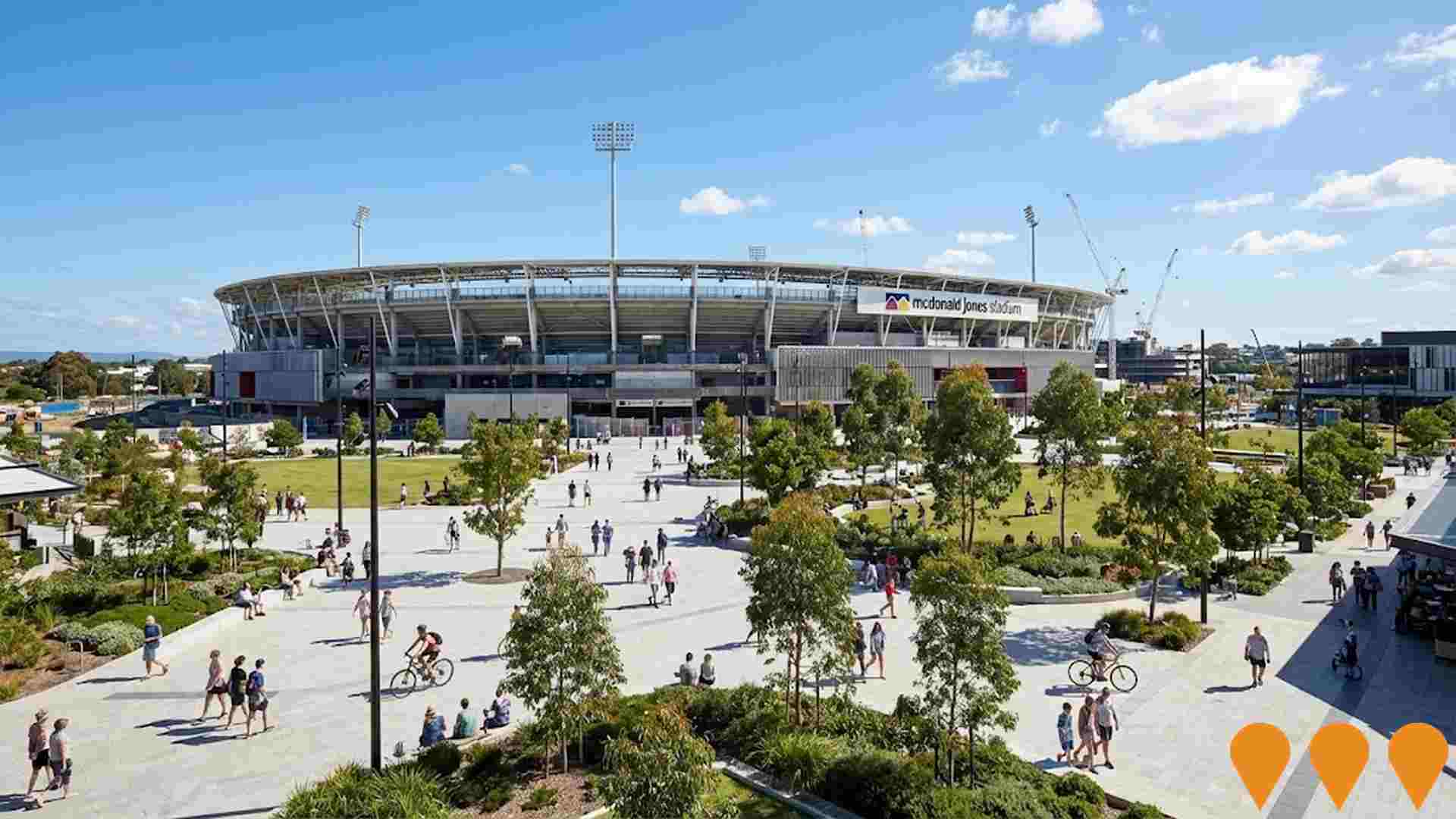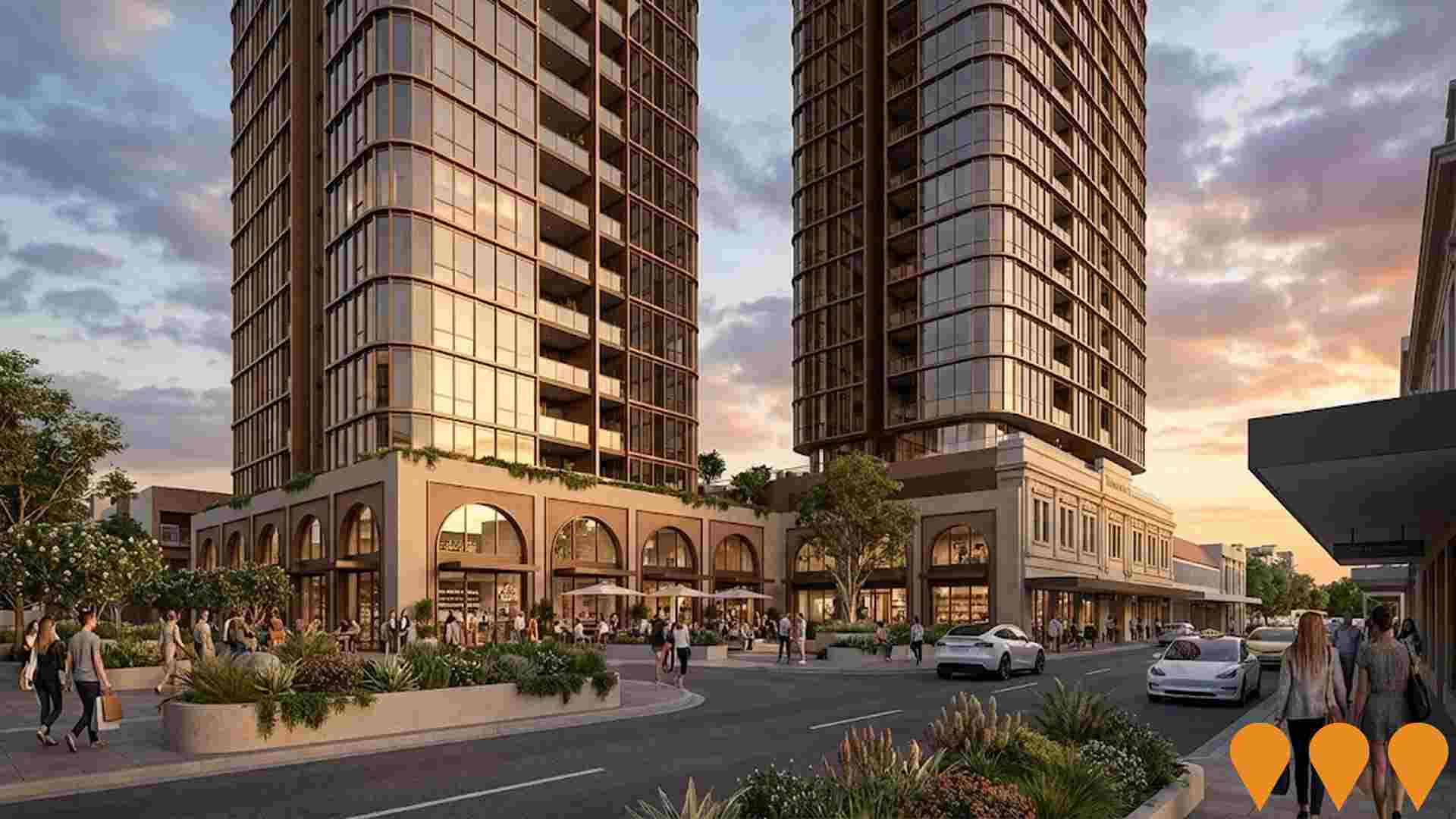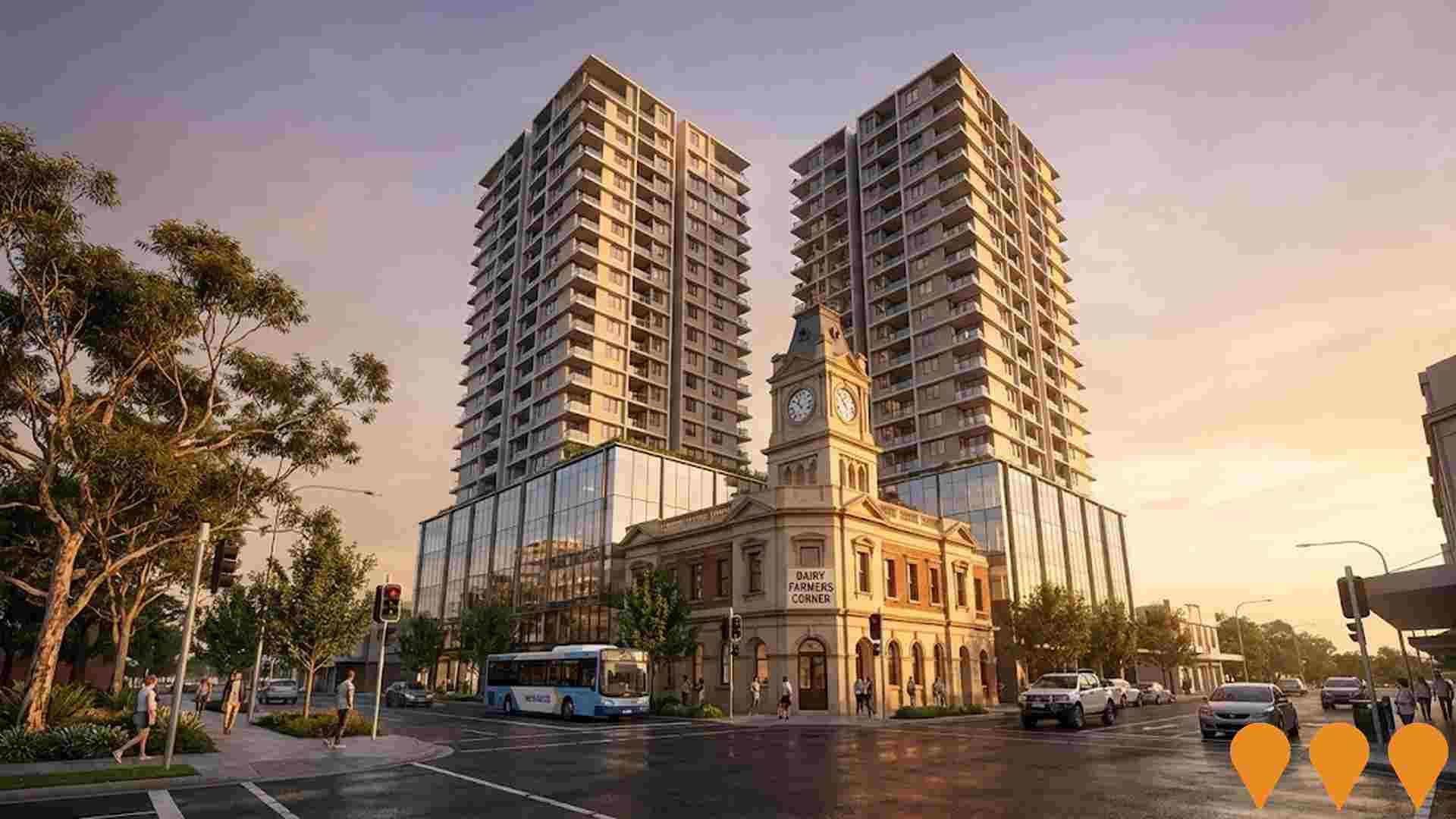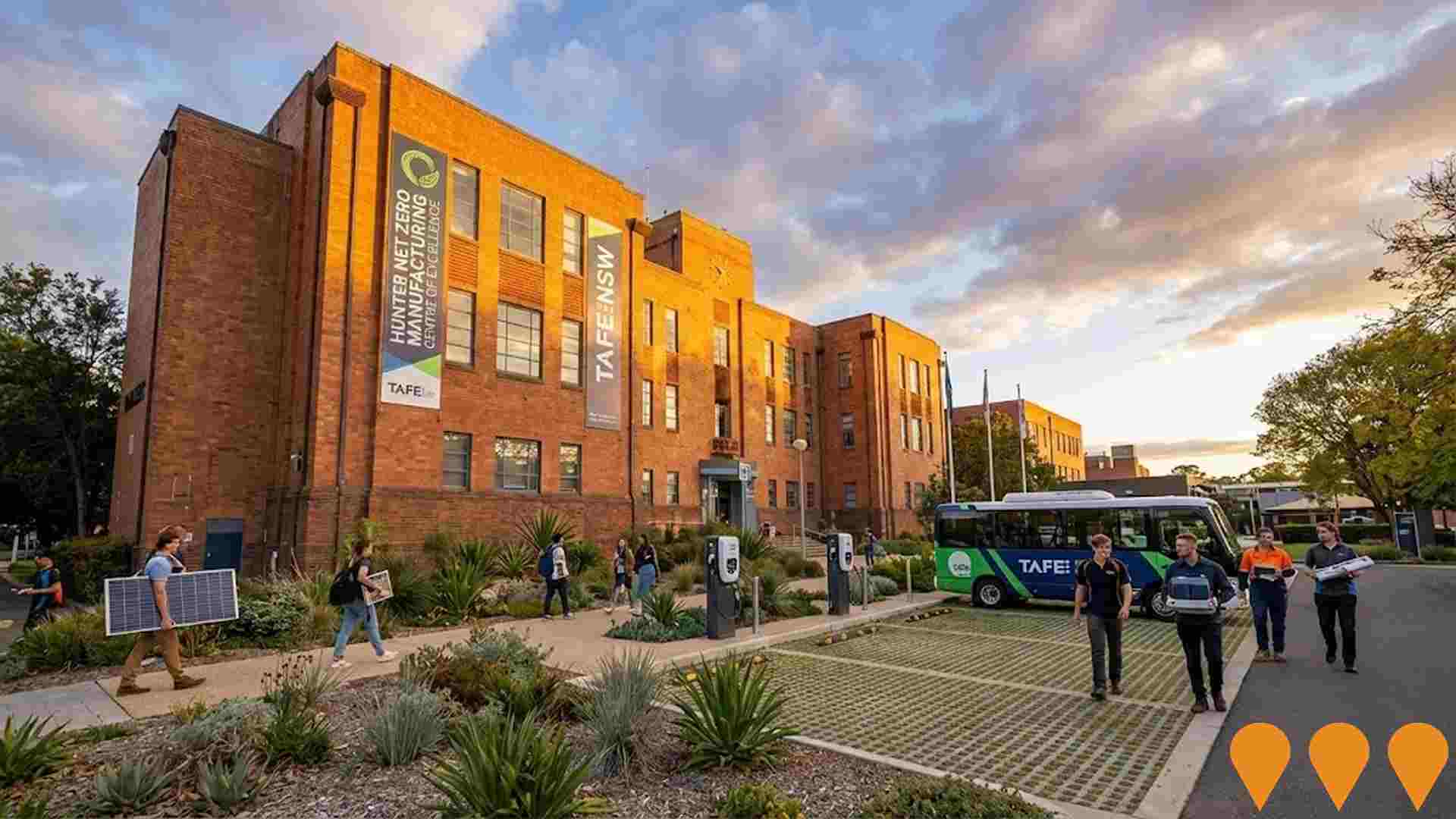Chart Color Schemes
est. as @ -- *
ABS ERP | -- people | --
2021 Census | -- people
Sales Activity
Curious about local property values? Filter the chart to assess the volume and appreciation (including resales) trends and regional comparisons, or scroll to the map below view this information at an individual property level.
Find a Recent Sale
Sales Detail
Population
Wickham - Carrington - Tighes Hill lies within the top quartile of areas nationally for population growth performance according to AreaSearch analysis of recent, and medium to long-term trends
Wickham - Carrington - Tighes Hill's population is 10,294 as of Aug 2025. This shows an increase of 1,123 people since the 2021 Census, which reported a population of 9,171. The change is inferred from ABS data: 10,211 in June 2024 and 295 validated new addresses since the Census date. The population density is 2,899 persons per square kilometer, placing it in the upper quartile nationally according to AreaSearch. Growth of 12.2% since 2021 exceeded non-metro areas (4.8%) and the SA4 region. Overseas migration contributed approximately 37.3% of overall population gains recently.
AreaSearch uses ABS/Geoscience Australia projections for each SA2 area, released in 2024 with a base year of 2022. For uncovered areas, NSW State Government's SA2 level projections are used, released in 2022 with a base year of 2021. Growth rates by age group are applied to all areas for years 2032 to 2041. Projected demographic trends show an above median population growth in regional areas nationally. The area is expected to increase by 1,920 persons to 2041, recording a gain of 17.9% over the 17 years.
Frequently Asked Questions - Population
Development
AreaSearch assessment of residential approval activity sees Wickham - Carrington - Tighes Hill among the top 30% of areas assessed nationwide
Wickham-Carrington-Tighes Hill has seen approximately 52 dwellings granted development approval annually. Over the past five financial years, from FY21 to FY25, around 261 homes were approved, with one more approved in FY26 so far. On average, about 5.7 people have moved into the area each year for every dwelling built during these years.
This substantial lag between supply and demand has led to heightened buyer competition and pricing pressures, with new properties being constructed at an average cost of $484,000. In FY26, around $10.0 million in commercial approvals have been registered, indicating balanced commercial development activity compared to the rest of NSW. When considering population, Wickham-Carrington-Tighes Hill has similar development levels to other areas in NSW, maintaining market equilibrium. However, building activity has slowed in recent years. The new building activity shows a shift towards compact living, with 14% detached houses and 86% medium to high-density housing.
This trend offers affordable entry pathways, attracting downsizers, investors, and first-time purchasers, marking a notable change from the area's existing housing composition of 56% houses. With around 438 people moving in for each dwelling approval, Wickham-Carrington-Tighes Hill indicates a developed market. Population forecasts estimate an increase of 1,837 residents by 2041, with building activity keeping pace with growth projections, although buyers may face increased competition as the population grows.
Frequently Asked Questions - Development
Infrastructure
Wickham - Carrington - Tighes Hill has strong levels of nearby infrastructure activity, ranking in the top 30% nationally
Changes to local infrastructure significantly influence an area's performance. AreaSearch has identified 41 projects that could impact the area. Key projects include Newcastle Future Transit Corridor, Hunter Park Precinct, Hunter Net Zero Manufacturing Centre of Excellence, and The Store Newcastle. Below is a list detailing those most relevant.
Professional plan users can use the search below to filter and access additional projects.
INFRASTRUCTURE SEARCH
 Denotes AI-based impression for illustrative purposes only, not to be taken as definitive under any circumstances. Please follow links and conduct other investigations from the project's source for actual imagery. Developers and project owners wishing us to use original imagery please Contact Us and we will do so.
Denotes AI-based impression for illustrative purposes only, not to be taken as definitive under any circumstances. Please follow links and conduct other investigations from the project's source for actual imagery. Developers and project owners wishing us to use original imagery please Contact Us and we will do so.
Frequently Asked Questions - Infrastructure
Newcastle Future Transit Corridor
Transport for NSW has confirmed the **Newcastle Future Transit Corridor** route, which will run between the Newcastle Interchange and the Broadmeadow precinct, primarily along Tudor Street. This corridor is being safeguarded to enable **future transport options**, such as light rail or rapid buses, supporting urban growth and projected housing and employment at Broadmeadow. The initial route segment closest to the Newcastle Interchange has been earmarked as the **Newcastle Future Infrastructure Corridor** to implement planning controls for its protection. A 2020 Strategic Business Case identified an extension from Newcastle Interchange to John Hunter Hospital via Broadmeadow as the most suitable long-term option, but noted bus solutions could precede light rail due to economic feasibility and to build patronage.

Transport Oriented Development Area - Hamilton Station
State-led planning reform allowing higher density residential development within 400 metres of Hamilton Station. The Transport Oriented Development planning controls commenced 13 May 2024, permitting residential flat buildings up to 22 metres (6 storeys) and shop top housing up to 24 metres with a maximum floor space ratio of 2.5:1. Development applications can now be lodged for residential flat buildings in residential and local centre zones, and shop top housing in commercial zones. All developments over 2,000 square metres gross floor area must include a mandatory 2% affordable housing contribution managed by registered community housing providers. Part of the broader NSW TOD Program aiming to deliver over 170,000 well-located homes near transport hubs across 37 stations over the next 15 years.

Hunter Park Precinct
$500 million mixed-use urban renewal project transforming 63 hectares around McDonald Jones Stadium into a sporting, entertainment, and lifestyle precinct. Includes 2,600 new homes, 50 hectares of public open space, state-of-the-art sporting facilities, entertainment venues, and 13,000sqm of commercial space.

The Store Newcastle
A major redevelopment of the historic former Newcastle Co-Operative Store site into two luxury residential towers (28 and 30 storeys) comprising 352 apartments (1-4 bedrooms), ground-floor retail and commercial spaces, and one acre of resort-style amenities including swimming pool, tennis court, rooftop observation deck, private event spaces, and landscaped areas. Developed by Doma Group, the project sets a new benchmark for apartment living in Newcastle with premium finishes and unparalleled city, harbour, and beach views.

Dairy Farmers Towers
Newcastle's tallest residential towers comprising 191 luxury apartments across two towers (99m and 89m) at the historic Dairy Farmers Corner. Features 1, 2 & 3 bedroom apartments with 5 floors of commercial space, pool with harbour views, gym, wine bar, shared work hub, and 360-degree Newcastle vistas. Plans include reimagining heritage structures for a public art installation.

Newcastle Art Gallery Expansion
Major expansion of Newcastle Art Gallery to create a contemporary arts and cultural hub, including new contemporary galleries, education facilities, conservation laboratories, public amenities, exhibition spaces, and community areas. Part of Newcastle's cultural precinct development strategy with enhanced accessibility and visitor experience to enhance cultural offerings in the city.

Hunter Net Zero Manufacturing Centre of Excellence
Establishing a Net Zero Manufacturing Centre of Excellence at TAFE NSW's Newcastle (Tighes Hill) campus to deliver microskills, microcredentials and higher apprenticeships aligned to clean energy and sustainable manufacturing. Jointly funded by the Australian Government and NSW Government with more than $60m over five years, including facility refurbishments and mobile training units to service regional NSW.

Newcastle 2040
City of Newcastle's Community Strategic Plan (CSP) setting the shared vision and priorities for the next 10+ years. Originally adopted in 2022 and revised in 2024/25, the updated CSP was endorsed by Council on 15 April 2025. It guides policies, strategies and actions across the LGA and is implemented through the Delivery Program and Operational Plan known as Delivering Newcastle 2040.

Employment
AreaSearch assessment positions Wickham - Carrington - Tighes Hill ahead of most Australian regions for employment performance
Wickham-Carrington-Tighes Hill has a highly educated workforce with strong representation in professional services. Its unemployment rate is 3.2%, lower than the Rest of NSW's 3.7%.
Employment growth over the past year was estimated at 2.0%. As of June 2025, 6,534 residents are employed with an unemployment rate of 0.5% below the regional average and a workforce participation rate of 71.8%, higher than Rest of NSW's 56.4%. Leading industries include health care & social assistance, education & training, and professional & technical services, with the latter showing particularly strong specialization at 1.9 times the regional level. Conversely, agriculture, forestry & fishing has lower representation at 0.4% compared to the regional average of 5.3%.
The worker-to-resident ratio is 0.7, indicating above-average local employment opportunities. Over the year to June 2025, employment increased by 2.0%, while labour force grew by 2.6%, resulting in an unemployment rate rise of 0.5 percentage points. By comparison, Rest of NSW saw employment decline by 0.1% and unemployment rise by 0.4 percentage points. According to Jobs and Skills Australia's national employment forecasts from May 2025, total employment is projected to grow by 6.6% over five years and 13.7% over ten years. Applying these projections to Wickham-Carrington-Tighes Hill's employment mix suggests local growth of approximately 7.2% over five years and 14.8% over ten years, though these are simple extrapolations for illustrative purposes only and do not account for localized population projections.
Frequently Asked Questions - Employment
Income
The area exhibits notably strong income performance, ranking higher than 70% of areas assessed nationally through AreaSearch analysis
AreaSearch's latest postcode level ATO data for financial year 2022 shows that income in Wickham - Carrington - Tighes Hill is higher than average nationally. The median income is $57,773 and the average income stands at $70,042. This contrasts with Rest of NSW's figures where the median income is $49,459 and the average income is $62,998. Based on Wage Price Index growth of 12.61% since financial year 2022, current estimates would be approximately $65,058 (median) and $78,874 (average) as of September 2025. Census 2021 income data shows personal income ranks at the 78th percentile with weekly earnings of $996, while household income sits at the 60th percentile. Income brackets indicate that 34.5% of individuals earn between $1,500 and $2,999 per week (3,551 individuals), which aligns with the metropolitan region where this cohort also represents 29.9%. High housing costs consume 18.0% of income, but strong earnings place disposable income at the 58th percentile. The area's SEIFA income ranking places it in the 7th decile.
Frequently Asked Questions - Income
Housing
Wickham - Carrington - Tighes Hill displays a diverse mix of dwelling types, with a higher proportion of rental properties than the broader region
The dwelling structure in Wickham - Carrington - Tighes Hill, as per the latest Census, consisted of 56.5% houses and 43.5% other dwellings (semi-detached, apartments, 'other' dwellings). This compares to Non-Metro NSW's 70.5% houses and 29.5% other dwellings. Home ownership in Wickham - Carrington - Tighes Hill stood at 24.1%, with the rest being mortgaged (32.1%) or rented (43.8%). The median monthly mortgage repayment was $1,985, above Non-Metro NSW's average of $1,962. Median weekly rent was $450, compared to Non-Metro NSW's $400. Nationally, Wickham - Carrington - Tighes Hill's mortgage repayments were higher at $1,985 versus the Australian average of $1,863, and rents were substantially above the national figure of $375.
Frequently Asked Questions - Housing
Household Composition
Wickham - Carrington - Tighes Hill features high concentrations of group households and lone person households, with a lower-than-average median household size
Family households constitute 58.0% of all households, including 19.2% couples with children, 27.5% couples without children, and 10.3% single parent families. Non-family households comprise the remaining 42.0%, with lone person households at 31.4% and group households making up 10.5%. The median household size is 2.2 people, which is smaller than the Rest of NSW average of 2.4.
Frequently Asked Questions - Households
Local Schools & Education
The educational profile of Wickham - Carrington - Tighes Hill exceeds national averages, with above-average qualification levels and academic performance metrics
Educational attainment in Wickham-Carrington-Tighes Hill is notably high, with 40.2% of residents aged 15 years and above holding university qualifications, compared to 21.3% in the rest of NSW and 26.1% in the SA4 region. Bachelor degrees are most prevalent at 27.4%, followed by postgraduate qualifications (9.4%) and graduate diplomas (3.4%). Vocational credentials are also common, with 31.4% of residents aged 15 years and above holding such qualifications – advanced diplomas (10.7%) and certificates (20.7%). Educational participation is high, with 28.2% of residents currently enrolled in formal education.
This includes 10.5% in tertiary education, 6.7% in primary education, and 4.3% pursuing secondary education. The area's three schools have a combined enrollment of 649 students, while demonstrating above-average socio-educational conditions (ICSEA: 1064). These schools focus exclusively on primary education, with secondary options available in nearby areas. Local school capacity is limited, with only 6.3 places per 100 residents compared to the regional average of 15.6, leading many families to travel for schooling.
Frequently Asked Questions - Education
Schools Detail
Nearby Services & Amenities
Transport
Transport servicing is good compared to other areas nationally based on assessment of service frequency, route connectivity and accessibility
Public transport analysis reveals 64 active transport stops operating within Wickham-Carrington-Tighes Hill. These stops offer a mix of train and bus services, with 23 individual routes providing a total of 2,564 weekly passenger trips. The area's transport accessibility is rated excellent, with residents typically located 160 meters from the nearest stop.
On average, service frequency across all routes is 366 trips per day, equating to approximately 40 weekly trips per individual stop.
Frequently Asked Questions - Transport
Transport Stops Detail
Health
Wickham - Carrington - Tighes Hill's residents are relatively healthy in comparison to broader Australia with common health conditions slightly more prevalent than average across both younger and older age cohorts
Wickham-Carrington-Tighes Hill's health metrics are close to national benchmarks.
Common health conditions are slightly more prevalent than average across both younger and older age cohorts. The rate of private health cover is very high at approximately 54% of the total population, which is around 5,599 people. The most common medical conditions in the area are mental health issues affecting 12.2% of residents and asthma impacting 8.5%. A total of 67.5% of residents declare themselves completely clear of medical ailments compared to 64.9% across Rest of NSW. The area has 12.7% of residents aged 65 and over, which is 1,304 people, lower than the 16.7% in Rest of NSW. This is broadly in line with the general population's health profile.
Frequently Asked Questions - Health
Cultural Diversity
Wickham - Carrington - Tighes Hill ranks below the Australian average when compared to other local markets across a number of language and cultural background related metrics
Wickham-Carrington-Tighes Hill, as per the census of 2016, had a cultural diversity index below average. This was evident in its birthplace demographics: 86.4% were born in Australia, and 90.5% held Australian citizenship. English was spoken at home by 93.1%.
Christianity was the predominant religion, practiced by 33.8% of the population. Notably, Judaism's representation in Wickham-Carrington-Tighes Hill matched that of Rest of NSW, both at 0.1%. The top three ancestral groups were English (30.2%), Australian (25.9%), and Irish (10.5%). However, Scottish ancestry was overrepresented at 9.4%, compared to the regional average of 8.4%. Similarly, Welsh (0.7% vs 0.8%) and Macedonian (0.4% vs 0.8%) ancestries showed notable divergences from their respective regional representations.
Frequently Asked Questions - Diversity
Age
Wickham - Carrington - Tighes Hill's population is younger than the national pattern
Wickham - Carrington - Tighes Hill has a median age of 34, which is lower than Rest of NSW's figure of 43 and Australia's figure of 38 years. The 25-34 cohort is over-represented in the area at 23.6%, compared to the Rest of NSW average, while the 5-14 age group is under-represented at 7.6%. This concentration of the 25-34 age group is higher than the national figure of 14.5%. Between 2021 and present, the percentage of the population aged 25 to 34 has increased from 21.5% to 23.6%, while the percentages for the 55 to 64 age group have decreased from 12.3% to 10.5% and the 45 to 54 age group have dropped from 12.5% to 11.3%. By 2041, demographic modeling projects significant changes in Wickham - Carrington - Tighes Hill's age profile. The 25-34 age cohort is projected to expand by 821 people (34%), from 2,432 to 3,254. Conversely, the 65-74 age group is projected to contract by 14 residents.


